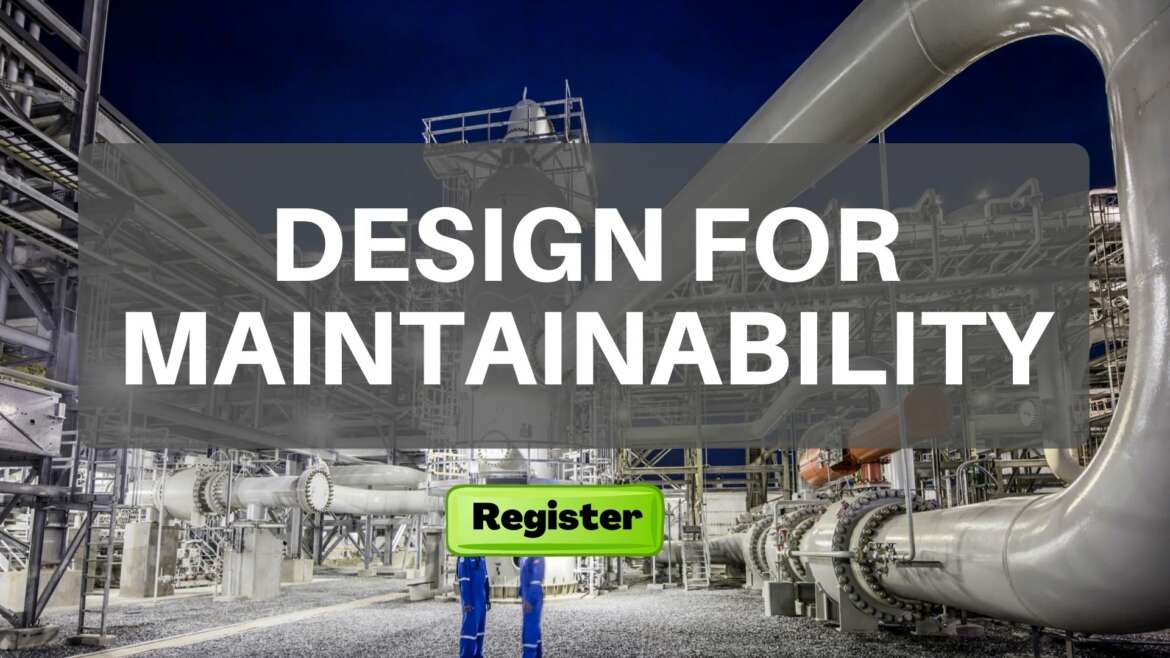Course Duration: 5 days | Time: 8am to 4pm | Course Locations: London, Dubai, Houston, Cape Town S.A
Course Description
The notion that equipment maintainability should be given strong consideration in the initial development stage is driven by the fact that maintenance and the associated costs are accrued over the entire life of the equipment. Because maintenance costs can be a significant factor in an equipment’s overall cost, it is essential that maintenance be considered early in the design when flexibility is high and design change costs are low Understanding how to address maintainability during design thus reducing the end users maintenance costs over the equipment life. It may, however, increase the costs to manufacture.
Design for Maintainability (DFM) is a closed loop process using the following principles:
1.Use a team approach with DFM as a goal. A company’s product development team should include individuals involved with design, manufacturing, product maintenance, and customer support.
2.Gather maintenance data and develop into information. Maintenance data can be gathered from the company’s service people, field data collection system, customer surveys, and warranty information. The data is then developed into information that supports decisions.
3.Develop/identify maintenance concepts using information. Some customers will dictate the maintenance concept they will use. In other cases, the manufacturer must develop the maintenance concept. The product development team can generate product maintenance concepts based on the information from Step 2. The selected maintenance concept is an important design constraint.
4.Design product using selected maintenance concepts. The design process begins using a systems approach and a variety of design tools, design rules, and approaches. At this stage, flexibility is great and design change costs are low.
5.Design, analyze, test, and improve the product. Based on the results of analysis and test (a prototype of portions of the product or even the entire product may be built), the design evolves. Maintenance concepts are reviewed and possibly revised. Flexibility is decreasing and design change costs are rising.
6.Manufacture the product and release to market. Engineering finalizes the design and releases the product to manufacturing. At this point, flexibility to modify the product maintenance features is low and the change costs are high.
7.Collect field maintenance data and develop information. Collect product field data in the form of customer feedback, warranty information, surveys, and service work. The information derived from this data can be used to evaluate the performance of the product in the field (Step 8) and in designing new equipment (Step 9). Design for Maintainability (DFM) is a closed loop process using the following principles:
8.Make field improvements as required by safety, economics, and other factors. Initial field performance may be lower than anticipated and additional changes to the design, procedures, or maintenance concept must be considered. At this point, modifying the product is very difficult and expensive. Only those changes dictated by customer acceptance or safety, or that are economically attractive will be made.
9.DFM process repeats with next generation product. Based on information generated from the field data, the design for maintainability process is repeated for the next generation product. Design rules may be revised, new tools developed, and design approaches validated or revised.
1.Use a team approach with DFM as a goal. A company’s product development team should include individuals involved with design, manufacturing, product maintenance, and customer support.
2.Gather maintenance data and develop into information. Maintenance data can be gathered from the company’s service people, field data collection system, customer surveys, and warranty information. The data is then developed into information that supports decisions.
3.Develop/identify maintenance concepts using information. Some customers will dictate the maintenance concept they will use. In other cases, the manufacturer must develop the maintenance concept. The product development team can generate product maintenance concepts based on the information from Step 2. The selected maintenance concept is an important design constraint.
4.Design product using selected maintenance concepts. The design process begins using a systems approach and a variety of design tools, design rules, and approaches. At this stage, flexibility is great and design change costs are low.
5.Design, analyze, test, and improve the product. Based on the results of analysis and test (a prototype of portions of the product or even the entire product may be built), the design evolves. Maintenance concepts are reviewed and possibly revised. Flexibility is decreasing and design change costs are rising.
6.Manufacture the product and release to market. Engineering finalizes the design and releases the product to manufacturing. At this point, flexibility to modify the product maintenance features is low and the change costs are high.
7.Collect field maintenance data and develop information. Collect product field data in the form of customer feedback, warranty information, surveys, and service work. The information derived from this data can be used to evaluate the performance of the product in the field (Step 8) and in designing new equipment (Step 9). Design for Maintainability (DFM) is a closed loop process using the following principles:
8.Make field improvements as required by safety, economics, and other factors. Initial field performance may be lower than anticipated and additional changes to the design, procedures, or maintenance concept must be considered. At this point, modifying the product is very difficult and expensive. Only those changes dictated by customer acceptance or safety, or that are economically attractive will be made.
9.DFM process repeats with next generation product. Based on information generated from the field data, the design for maintainability process is repeated for the next generation product. Design rules may be revised, new tools developed, and design approaches validated or revised.
Project Engineers and Engineering Managers, Equipment designers and design team leaders, Maintenance and Reliability engineers and Managers.
Design for maintainability
$1,950
Categories: Reliability and Maintenance, Technical Courses
Product ID: 1400





